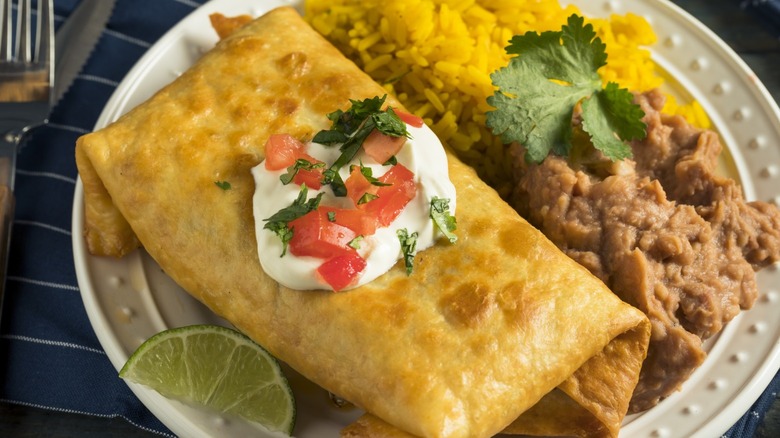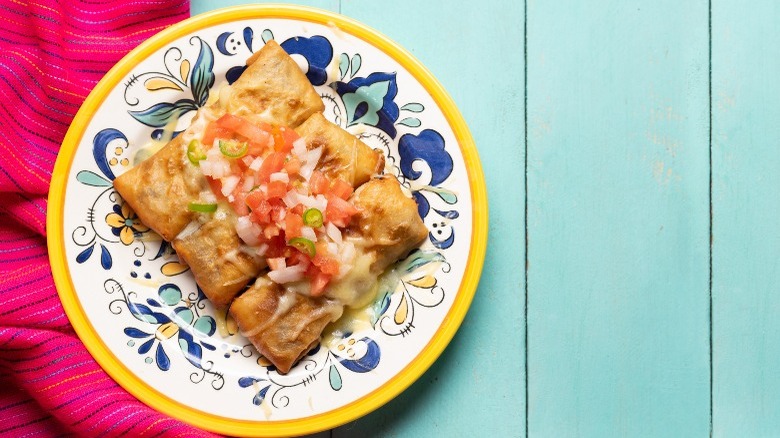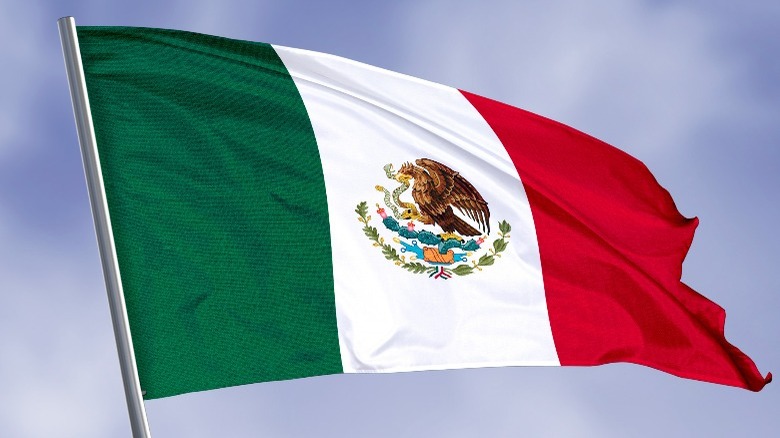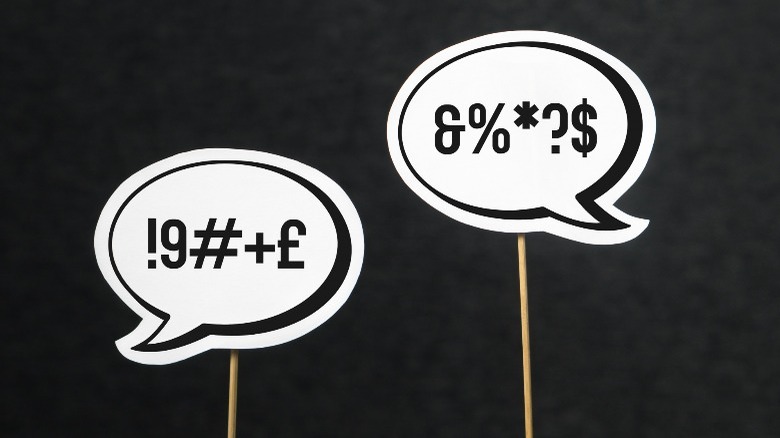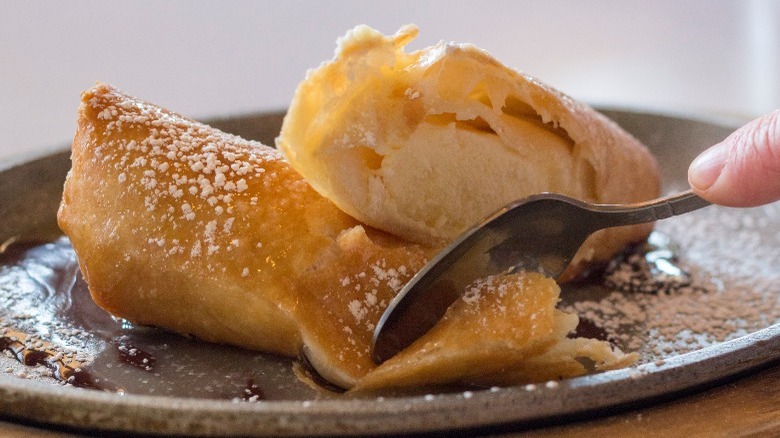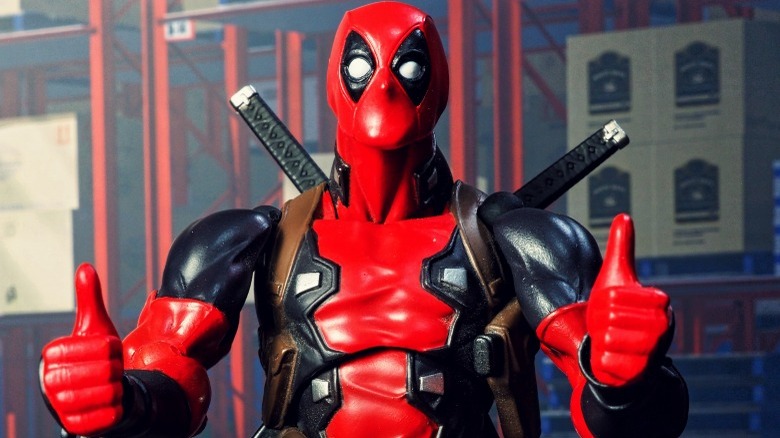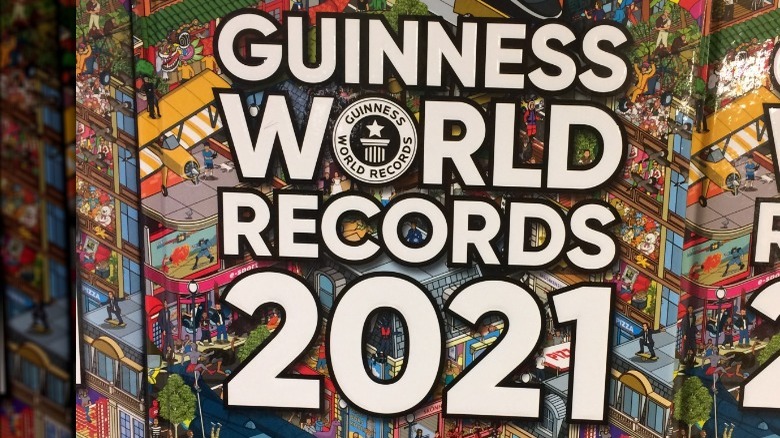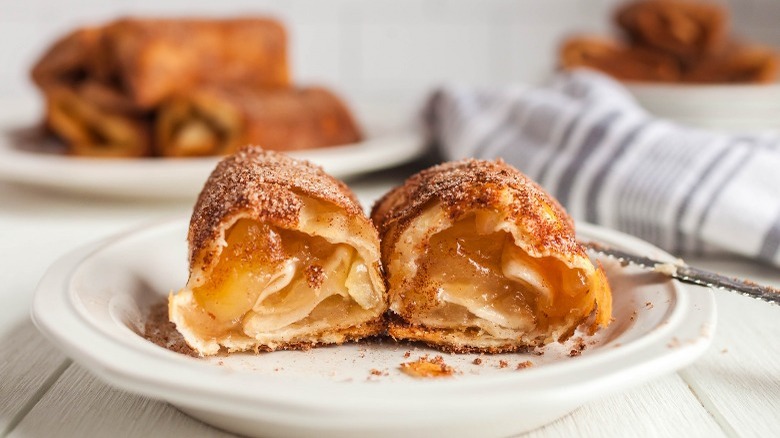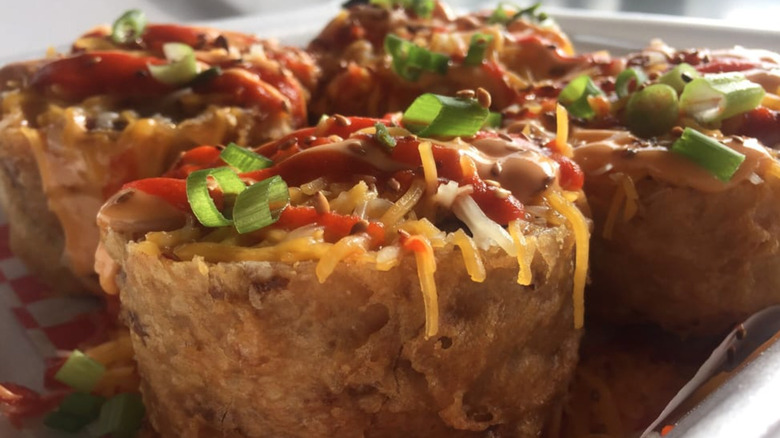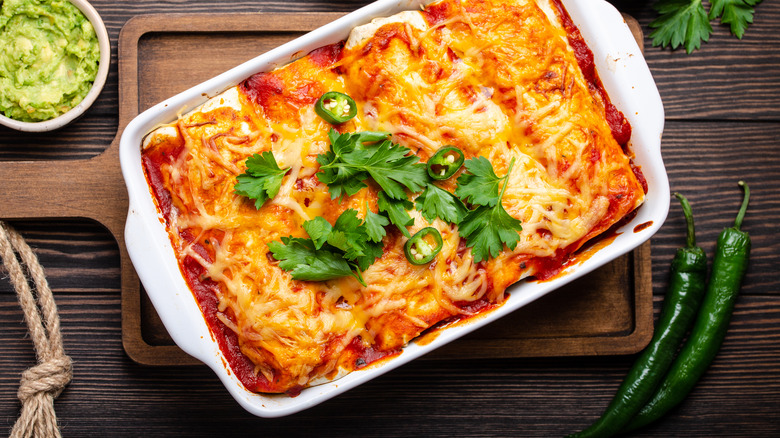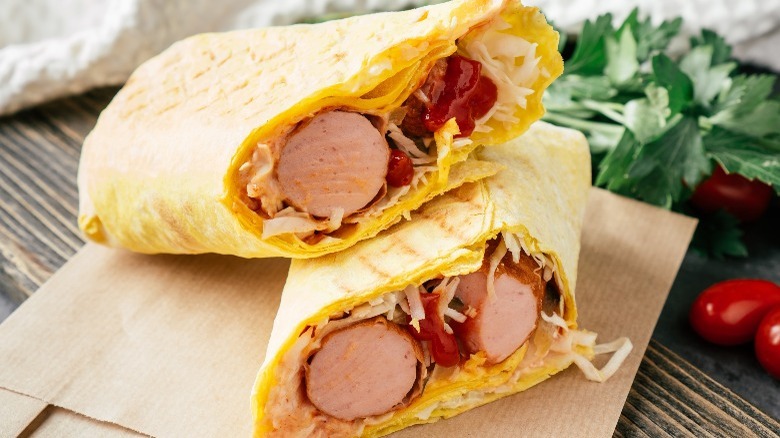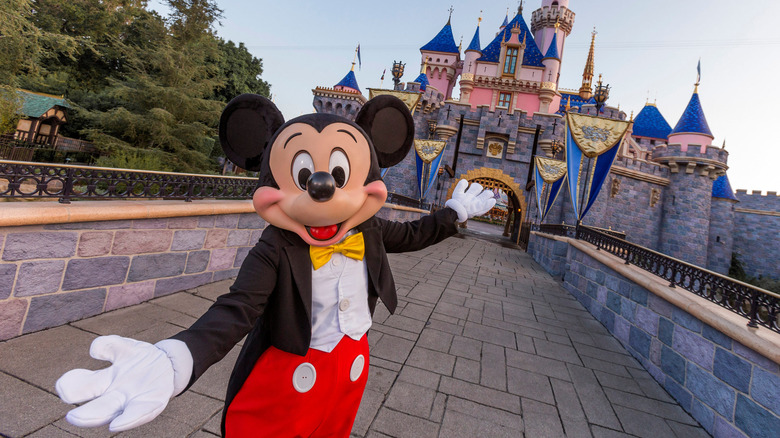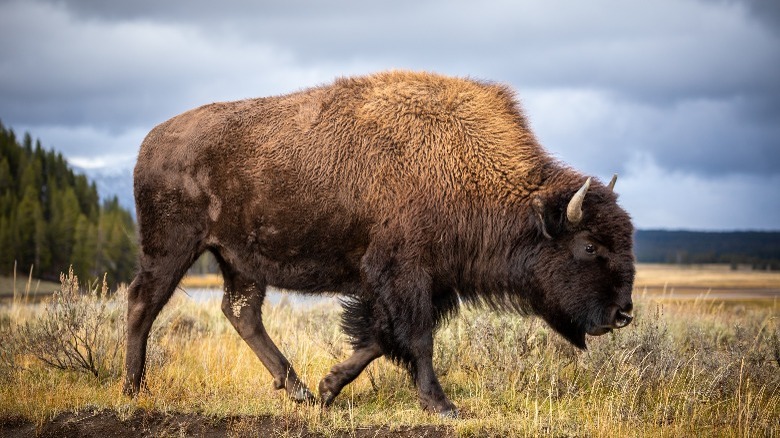The Untold Truth Of Chimichangas
We may receive a commission on purchases made from links.
Chimichangas bring crunchy spice to Southwestern and Tex-Mex cuisine, and as far as we can tell, they probably were not created in Texas. Their origin is something of a mystery, a subject of debate between storied restaurants and long-held traditions. They are the food of superheroes and Disney-goers. They are also a shockingly flexible vehicle of gastronomic invention.
Demonstrating the unstoppable American urge to throw anything and everything into the deep-fryer (looking at you, county fair deep-fried butter sticks), chimichangas heat up the classic burrito into something crispy, flakey, comforting, and decadent. Frankly, they are a thing of beauty.
A thing of beauty with a lot of history, that is. Want to know more about how the lore surrounding how the chimi came to be, creative takes on this dish, and what the world's largest chimichanga weighed? Read on to learn the untold truth of the culinary masterpiece that is the chimichanga.
Two Arizona restaurants take credit for the dish
There's more drama behind the chimichanga than many realize. It begins, as all good stories do, at the very beginning with the creation of the iconic dish. Two restaurants, both of which still operate today with large and loyal fanbases, famously claim they were the first to concoct a beautiful mistake that resulted in the food item that would become known as the chimichanga.
Macayo's Mexican Food in Phoenix, Arizona, maintains their founder, Woody Johnson, dropped a burrito in the deep-fryer accidentally. He apparently realized the thing he and his butterfingers created tasted great. Since then, various styles of the classic chimi have become the restaurant's claim to fame. The biggest competition for the chimichanga's fabled first dip in the fryer comes from El Charro Cafe in Tucson. In an interview with the Los Angeles Times, owner Carlotta Flores said Monica Flin, Flores' great-grand-aunt and former restaurant owner, accidentally created the first chimichanga when — you guessed it — she dropped a burrito in hot oil.
As the Phoenix New Times noted, Macayo's and El Charro Cafe are not the only establishments to take credit for the chimi, but they are the restaurants whose names have become synonymous with the dish.
Or maybe they were actually invented in Mexico
Chimichangas were, are, and will likely remain popular in northern Mexico. Chihuahua, Sonora, and Sinaloa — the three most northwestern Mexican states — have a friendly rivalry with the U.S. over who has the superior recipe. Each state and region has unique fillings, seasonings, and even preferred fats for frying.
And there's a theory that the chimichanga might've not been created in Tucson or Phoenix at all. Per The New York Times, some hold the belief that the dish actually started in Mexico and then made its way up to the United States. As a manager of Tucson restaurant Los Portales told Zócalo, "The chimichangas in Mexico are smaller than the ones here, but they have definitely been around longer." Per the Phoenix New Times, it's been said that perhaps they were actually invented by Chinese immigrants who'd settled in Mexico in the 1900s, or by people native to Mexico inspired by Chinese cuisine.
Where did the name come from?
As if its tangled history and the high legends of its creation weren't complicated enough, the story behind the name "chimichanga" also is a bit murky. We can't be sure where it came from, nor can we be totally sure what it was that inspired whoever named it. That said, there are a few schools of thought.
According to one of the chimi's origin stories, it is believed that the name came from an adult's attempt to not swear. Per Taste, the latter half of "chimichanga" sounds like a cuss word in Spanish, and according to this particular theory, when Monica Flin of Tucson's El Charro unintentionally plopped a burrito in the fryer, she made up a new word so as not to use an expletive around kids. However, as What's Cooking America noted, Macayo's in Phoenix says "chimichanga" loosely means "toasted monkey" ("chango" is "monkey" in Spanish). Another theory, as OC Weekly pointed out, is that the word may or may not be rooted in Chinese. And according to El Charro Cafe, the word is a nonsense word, closer to "thingamajig." Whatever the case, the name stuck.
Yes, cheesecake chimichangas are a thing
We bet there are a lot of things you didn't know about cheesecake, including the fact that cheesecake chimichangas exist. Yes, they are a real thing, and they might lurk closer to home than you think. These stealthy menu items flesh out dessert menus for restaurants across the country, and if you're really ambitious, you can try making them yourself.
Cheesecake chimichangas come in many flavors, but the heart is simple. While a traditional chimichanga packs most of its goodies on the inside, cheesecake chimichangas usually have cheesecake and only cheesecake in the middle. The flavors swirled, drizzled, or layered on regular cheesecakes appear as toppings, like the caramel sauce on the version from Southside Jonesy's Taco House. Other restaurants take Taco Bueno's approach and make their cheesecake chimichangas churro style with sugar and spice on the outside of the tortilla.
If you love cheesecake but wish it came with a little more crunch, look for these treats at your local taco shops. You may be surprised what flavors you discover. You may have a regional variety unlike anything we've mentioned.
They're a comic book catchphrase
Marvel's trash-talking, third-wall-breaking anti-hero Deadpool has a very close and personal relationship with the chimichanga. Although he frequently enjoys other kinds of junk food in the comics, cartoons, and films he appears in, the chimichanga became his literal catchphrase.
Only the writers know why of all the deep-fried beauties in the world, the chimichanga won this particular pageant, but the creative choice secured the dish's future in the hearts and minds of the character's broad fanbase. Hey, given that the word may or may not have been inspired by a cuss word, it suits the foul-mouthed character.
It's hard to overstate how entrenched chimichangas are with Deadpool and his popular image. You can try the official recipe for Deadpool's chimichanga in either one of two Marvel cookbooks, one of which is entirely dedicated to Deadpool. Prefer collectables? Good news. Funko Pop has you covered with a tiny Deadpool figurine selling chimichangas out of his very own food truck. His fans love him, but they seem to love him most when he has a chimi.
The longest chimichanga was over 25 feet long
While the backstory of the dish may be up for debate, no one can argue over who has the biggest chimichanga. It's a matter of record. In fact, it's a world record.
One of the dueling restaurants with a claim to the chimichanga's first dip in a deep-fryer, Macayo's organized an official world record attempt as part of the restaurant's 75-year anniversary festivities. Restaurant employees teamed up in 2021 to make a 25-foot and 7-inch chimichanga. Macayo's shared the monster meal, made with 500 pounds of shredded chicken and over 200 pounds each of refried beans and rice, with the community.
The record is Guinness-certified. Other contenders may attempt to break the record in the future, but half the battle is deep-frying a creation that uses more than 700 gallons of soybean oil. It took Macayo's two years to prepare for the stunt, and they were the first to attempt it.
Chimichanga has a loose definition
For a meal that requires such careful wrapping, the chimichanga's name has a very loose definition. According to Merriam-Webster, a chimichanga is "a tortilla wrapped around a filling (as of meat) and deep-fried."
This is noteworthy as much for what it doesn't mention as what it does. Given the lore surrounding chimichangas being accidental delicacies, it makes sense to define them as deep-fried burritos.
The loose definition also gives chimichangas room to grow. You can probably imagine 12 foods that taste better when they're fried, and lots of them could make a great filling for a chimichanga. Hey, as long as it's wrapped in a tortilla and dropped in a deep-fryer, it counts. You could wrap a roll of sushi in a tortilla, fry it, and call it a chimichanga. The definition doesn't even expressly say a chimichanga must be edible, either. The only limits are your imagination and your sense of culinary ethics. That said, with great chimi power comes great chimi responsibility; just because it can be a chimichanga doesn't mean it should be.
They rock the Asian fusion scene
The chimichanga's flexible definition lends itself well to improvisation, creativity, and yes, new fillings. You may be reluctant to stray too far from the standard chimi ingredients because you do not want to mess with perfection, but the Asian-Mexican fusion food scene is sure to change your mind.
Kimchichanga, located in Riverside, California, offers a number of Asian-Mexican fusion dishes, including a chimichanga that is stuffed with kimchi fried rice. (And yes, said you would be correct to assume that the kimchi rice chimichanga does indeed share its name with the restaurant.) A San Francisco eatery called Aria Korean Tapas offers a chimichanga with bulgogi beef, Korean fried chicken, kimchi, mozzarella, and rice cooked with sesame oil. KoMex, a Korean-Mexican spot in Las Vegas, has a Fusion Chimichanga that is filled with bulgogi padded in Spanish rice. We know one thing to be true: All of these spins on the classic chimichanga sound like must-try items.
Chimichangas, burritos, and enchiladas, oh my
Chimichangas, burritos, and enchiladas have a lot in common in that they all feature the same basic ingredients and design. To make any one of the three, you need tortillas and a filling that you roll up inside before you cook your chosen concoction. However, a few key differences will help you tell them apart.
The biggest difference is how you cook each dish. A burrito usually comes grilled, toasted, or baked. Enchiladas often cook in a deeper dish with some kind of cheese or sauce. Chimichangas are, of course, deep fried. Then there's the rule of fork: Of the three, burritos are usually the only kind you can eat without a fork, though some particularly sturdy chimichangas may pass the finger food test as well. Enchiladas always require a utensil.
The last difference sets enchiladas apart from burritos and chimichangas. If it has a corn tortilla, there's a good chance it is an enchilada. Burritos and chimichangas, on the other hand, typically are made with flour tortillas.
Chimichanga dogs exist
Once upon a time, someone looked at a chimichanga and a hot dog and thought they'd go together awfully well. Actually, it seems like several people had similar ideas, and they all went in slightly different directions. Thanks to their inspiration, there are different chimichanga dogs across the United States. Think of them as crispier pigs in blankets or a cousin of corn dogs without the stick.
In the Adirondacks of Upstate New York, the chimi dog looks most like a chimi. The Adirondack Dog House serves them with cheese, lettuce, tomato, salsa and sour cream. If you didn't know what lurked inside, you could easily mistake it for a more traditional dish.
The Arizona version takes a different route, combining chili cheese dogs with chimichangas. They're popular enough for Hormel to provide a recipe for enthusiastic home chefs. Nose around at the next county fair or your seasonal ice cream stand to see if you have a local breed of chimichanga dog.
Disney has its own chimichangas
Unless you happen to be friends with a diehard Disney foodie, there is a good chance you've never heard of the Disney chimichanga. Apparently they're fit for a princess.
The Mouse's take on the chimi is modest, as all deep-fried snacks should be, and no, they aren't in the shape of the mascot, a la Mickey ice cream bars. As for where one might acquire one of these chimis? You'll find them at Edelweiss Snacks in Fantasyland. Yes, the chalet-themed eatery where you can get your paws on one of the theme park's famous turkey legs is where you can order a chimichanga.
Disney also launched a breakfast chimi. While the lunch and dinner option serves up a blend of beef and beans, the breakfast chimichanga keeps it classic with eggs, cheese, and bacon. You can find the breakfast version in Ship to Shore Marketplace in Frontierland when it's available. Disney has a habit of changing up the menu, so if you see a breakfast chimichanga in the wild at a Disney park, grab it while it's hot.
Bison chimichangas may be the next big thing
If you'd like to mix up the protein you use in your chimichangas, why not give bison a try? There's a lot you need to know about bison meat, and most of it's good news for healthy eaters in search of a leaner red meat. As The New York Times noted in 2016, bison meat has grown in popularity in recent years, and it's become available in various stores, including Costco. What does it look like in the world of chimichangas, though?
Not unlike fish tacos, bison burritos and chimichangas take a leaner approach to a beloved dish. Of course, a traditional chimichanga is fried, so it's not like a bison chimichanga is the leanest dish to ever be created. That said, Minnesota Grown offers a recipe for a baked version of a bison chimichanga, so you could always go that route. But if you're looking for a rendition that involves oil, the bison chimi recipe on the Community Markets website should do the trick.
Per Consumer Reports, bison is much more expensive than ground beef, shredded chicken, or even pulled pork, so that's a bit of a drawback. Fortunately, the classic fillings aren't going anywhere, and who doesn't like a tried-and-true chicken chimichanga?
